 W
WThe Battle of Amsteg saw a Republican French division under General of Division Claude Lecourbe face a brigade of Habsburg Austrian soldiers led by General-major Joseph Anton von Simbschen. Lecourbe's offensive began on 14 August when six columns of French infantry advanced on the upper Reuss valley from the north and east. By 16 August, Lecourbe's forces had driven Simbschen's Austrians from the valley and seized control of the strategic Gotthard Pass between Italy and Switzerland.
 W
WThe Battle of Arbedo was fought on June 30, 1422, between the Duchy of Milan and the Swiss Confederation.
 W
WThe Battle of Bruderholz took place on 22 March 1499 in the Swabian War between Swabian troops and forces of the Old Swiss Confederacy. The Swabians had raided several Swiss villages and were on their way back when they met troops from Lucerne, Solothurn, and Berne, who also came back from a raid in the Alsace. At the Bruderholz, a hill south of Basel, the Swiss engaged the three times more numerous Swabians in battle and defeated them.
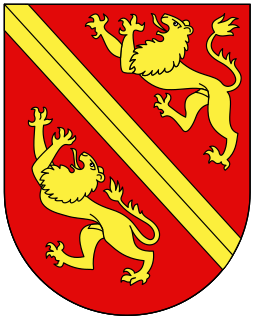 W
WThe Burgdorferkrieg or Kyburgerkrieg was a war in 1383-84 between the counts of Neu-Kyburg and the city of Bern for supremacy in the County of Burgundy in what is now Switzerland.
 W
WThe Battle of Calven took place on May 22, 1499 at the exit of the Val Müstair in the Grisons to the Vinschgau in County of Tyrol between the forces of King Maximilian I of the House of Habsburg and those of the free federation of the Three Leagues of the Grisons. It was the decisive battle in the southern Grisons of the Swabian War; after the defeat of the Habsburg troops, the king had to abandon his attempts to control the Engadin and the Val Müstair. The focus of operations in the Swabian War subsequently shifted again to the northern border of the Old Swiss Confederacy.
 W
WThe Battle of Castione was fought between the Golden Ambrosian Republic (Milan) and the canton of Uri on 6 July 1449. The site of the battle is near that of the earlier Battle of Arbedo, both in the territory of the current-day municipality of Arbedo-Castione in the Swiss canton of Ticino.
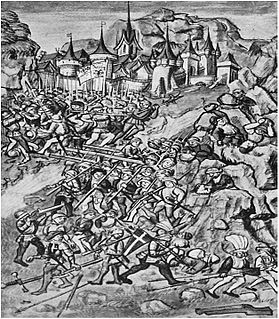 W
WThe Battle of Crevola was fought in the spring of 1487, between a marauding Swiss army (from the Valais and Lucerne) and troops from the Duchy of Milan, for the supremacy of the Val d'Ossola (Eschental).
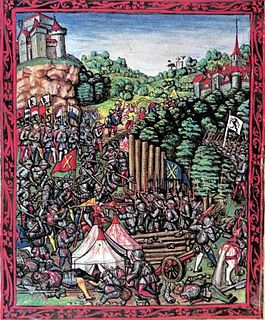 W
WThe Battle of Frastanz between an army of the Old Swiss Confederacy and the troops of King Maximilian I of the Holy Roman Empire took place on 20 April 1499. In one of the many raids of the Swabian War, an expedition of Habsburg troops had plundered some villages in the Swiss Confederacy, who responded by sending an army to Vorarlberg. At Frastanz, a few kilometers south-east of Feldkirch, the Habsburg troops had blocked the entry to the Montafon valley with a strong wooden fortification called a Letzi. The Swiss used a flanking maneuver to bypass the Letzi and after a hard battle routed Maximilian's army. Many Landsknechte drowned in the river Ill.
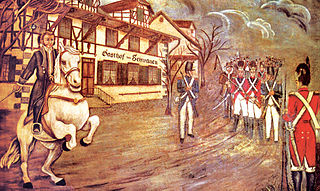 W
WThe Freiämtersturm in December 1830 was a bloodless revolution in the Swiss canton of Aargau. The dissatisfied rural population of the Freie Ämter region in Aargau marched on the cantonal capital of Aarau to demand changes in the cantonal constitution. The Freiämtersturm, together with other uprisings in 1830–31 led to the end of the Restoration period and the beginning of the liberal Regeneration period. The changes during the Regeneration led to the creation of the Federal State in 1848.
 W
WIn the Battle of Giornico a Swiss force of 600 defeated 10,000 Milanese troops.
 W
WThe Battle of Gotthard Pass or Battle of St. Gotthard Pass saw an Imperial Russian army commanded by Field Marshal Alexander Suvorov supported by two Habsburg Austrian brigades attack a Republican French division under General of Division Claude Lecourbe. The Austro-Russian army successfully captured the Gotthard Pass after stiff fighting on the first day. Suvorov's main body was assisted by a Russian flanking column led by Lieutenant General Andrei Rosenberg and a smaller Austrian flanking column under General-major Franz Xaver von Auffenberg. The next day, Suvorov's army fought its way north along the upper Reuss River valley past the Teufelsbrücke in Schöllenen Gorge. By 26 September the army reached Altdorf near Lake Lucerne.
 W
WThe Battle of Grandson, which took place on 2 March 1476, was part of the Burgundian Wars, and resulted in a major defeat for Charles the Bold, Duke of Burgundy, at the hands of the Swiss.
 W
WThe Battle of Grauholz on 5 March 1798 was a battle between a Bernese army under Karl Ludwig von Erlach against the French Revolutionary Army under Balthazar Alexis Henri Schauenburg. The battle took place at Grauholz, a wooded hill in what is now the municipalities of Urtenen-Schönbühl and Moosseedorf in the canton of Bern in Switzerland. The government of Bern had already surrendered the previous day and the Bernese defeat at Grauholz ended their resistance to the French in the north of the canton.
 W
WThe Gümmenenkrieg was a war between the emergent city-states of Bern and Fribourg in 1331-33 in what is now Switzerland. The war pitted Bern and the new Swiss Confederation against the Habsburg-supported city of Fribourg and local nobles. It was also the first in a series of battles that brought the Habsburgs and Fribourg into prominence in the County of Burgundy. The war ended without resolving anything and led to other wars between Bern and Fribourg.
 W
WThe Battle of Hard was the first large-scale battle in the Swabian War, waged between the Imperials under the Holy Roman Emperor Maximilian I and the Swiss Confederates. The battle was fought on 20 February 1499, a cold and foggy day, between 10,000 Imperial troops, mostly from the Swabian Circles, and a smaller number of Swiss troops, often called Reisläufer.
 W
WThe Battle of St. Jakob an der Birs was fought between the Old Swiss Confederacy and French mercenaries, on the banks of the river Birs. The battle took place on 26 August 1444 and was part of the Old Zürich War. The site of the battle was near Münchenstein, Switzerland, just over 1 km outside the city walls of Basel, today within Basel's St-Alban district.
 W
WThe Second War of Kappel was an armed conflict in 1531 between the Protestant and the Roman Catholic cantons of the Old Swiss Confederacy during the Reformation in Switzerland.
 W
WThe Battle of Laupen was fought in June 1339, between Bern and its allies on one side, and Freiburg together with feudal landholders from the County of Burgundy and Habsburg territories on the other. Bern was victorious, consolidating its position in the region. As a consequence of the conflict, the relations of Bern and the Swiss Confederacy tightened, resulting in Bern's permanent accession in 1353.
 W
WThe Battle of Linth River saw a Republican French division under General of Division Jean-de-Dieu Soult face a force of Habsburg Austrian, Imperial Russian, and Swiss soldiers led by Feldmarschall-Leutnant Friedrich Freiherr von Hotze in Switzerland. Soult carefully planned and his troops carried out a successful assault crossing of the Linth River between Lake Zurich and the Walensee. Hotze's death early in the action disorganized the Allied defenders who were defeated and forced to retreat, abandoning supplies accumulated for Field Marshal Alexander Suvorov's approaching army. On the same day, General of Division André Masséna's French Army of Helvetia defeated Lieutenant General Alexander Korsakov's Russian army in the Second Battle of Zurich and a French brigade turned back another Austrian force near Mollis. Both Korsakov's Russians and Hotze's survivors, led by Feldmarschall-Leutnant Franz Petrasch withdrew north of the Rhine River.
 W
WThe Battle of Marignano was the last major engagement of the War of the League of Cambrai and took place on 13-14 September 1515, near the town now called Melegnano, 16 km southeast of Milan. It pitted the French army, composed of the best heavy cavalry and artillery in Europe, led by Francis I, newly crowned King of France, against the Old Swiss Confederacy, whose mercenaries until that point were regarded as the best medieval infantry force in Europe. With the French were German landsknechts, bitter rivals of the Swiss for fame and renown in war, and their late arriving Venetian allies.
 W
WThe Battle of Morat was a battle in the Burgundian Wars (1474–77) that was fought on 22 June 1476 between Charles the Bold, the Duke of Burgundy, and a Swiss Confederate army at Morat/Murten, about 30 kilometres from Bern. The result was a crushing defeat for the Burgundians at the hands of the Swiss.
 W
WThe Battle of Morgarten occurred on 15 November 1315, when a 1,500-strong force from the Swiss Confederacy ambushed an army of Habsburg soldiers and knights on the shores of Lake Ägeri near the Morgarten Pass in Switzerland. The Swiss, led by Werner Stauffacher, defeated the Habsburg troops, who were under the command of Duke Leopold I. The Swiss victory consolidated the Eternal League of the Three Forest Cantons, which formed the core of modern Switzerland.
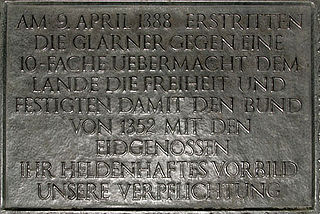 W
WThe Battle of Näfels was fought on 9 April 1388 between Glarus with its allies the Old Swiss Confederation, and the Habsburgs. It was a decisive Glarner victory despite being outnumbered sixteen to one.
 W
WThe Battle of Novara was a battle of the War of the League of Cambrai fought on 6 June 1513, near Novara, in Northern Italy. A French attacking force was routed by allied Milanese–Swiss troops, the consequence of which was that France was forced to withdraw entirely from Italy.
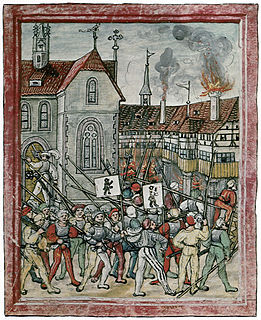 W
WThe Rorschacher Klosterbruch or St. Gallerkrieg was a war between the Abbey of Saint Gall, Zürich, Lucerne, Schwyz and Glarus against the city of St. Gallen and Appenzell in 1489 to 1490.
 W
WThe Battle of St. Jakob an der Sihl was a battle of the Old Zürich War that occurred on July 22, 1443, resulting in a defeat for Zürich.
 W
WThe Battle of Schwaderloh took place on April 11, 1499 near Triboltingen, a village on the Swiss shores of the Untersee just south of Constance. It was one of the major battles of the Swabian War between the Old Swiss Confederacy and the forces of the Swabian League and of Emperor Maximilian I.
 W
WThe Second Battle of Ulrichen was a battle fought in 1419 between the Old Swiss Confederacy lead by Bern and rebels from Valais near Ulrichen in the district of Goms in the canton of Valais in Switzerland. Negotiations after the battle led to the end of the Raron affair and self-determination for Valais.
 W
WThe Battle of Sempach was fought on 9 July 1386, between Leopold III, Duke of Austria and the Old Swiss Confederacy. The battle was a decisive Swiss victory in which Duke Leopold and numerous Austrian nobles died. The victory helped turn the loosely allied Swiss Confederation into a more unified nation and is seen as a turning point in the growth of Switzerland.
 W
WThe Battle of Sörenberg was fought in 1380, between the Entlebuch and Obwalden. It was the culmination of a conflict over the right to alpine pastures (alps). The immediate cause was a cattle raid at an alp now known as Schlachtalp, at the slope of the Brienzer Rothorn, above the village Sörenberg.
 W
WLudovico Maria Sforza, also known as Ludovico il Moro, was an Italian Renaissance prince who ruled as Duke of Milan from 1494, following the death of his nephew Gian Galeazzo Sforza, until 1499. A member of the Sforza family, he was the fourth son of Francesco I Sforza. He was famed as a patron of Leonardo da Vinci and other artists, and presided over the final and most productive stage of the Milanese Renaissance. He is probably best known as the man who commissioned The Last Supper.
 W
WIn the First Battle of Zurich on 4 – 7 June 1799, French general André Masséna was forced to yield the city to the Austrians under Archduke Charles and retreat beyond the Limmat, where he managed to fortify his positions, resulting in a stalemate.
 W
WThe Second Battle of Zurich was a key victory by the Republican French army in Switzerland led by André Masséna over an Austrian and Russian force commanded by Alexander Korsakov near Zürich. It broke the stalemate that had resulted from the First Battle of Zurich three months earlier and led to the withdrawal of Russia from the Second Coalition. Most of the fighting took place on both banks of the river Limmat up to the gates of Zürich, and within the city itself.